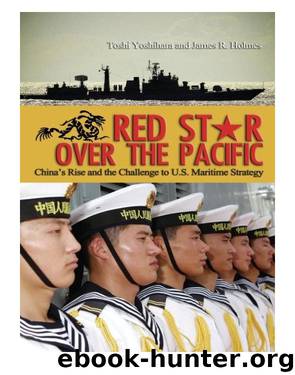Red Star Over the Pacific by Toshi Yoshihara

Author:Toshi Yoshihara
Language: eng
Format: epub, pdf
Publisher: Naval Institute Press
Published: 2011-05-23T16:00:00+00:00
POTENTIAL DEPLOYMENT PATTERNS
Beyond force sizing, China must also consider a range of possible deployment patterns. U.S. analysts have recently taken to speculating about the logic of a “bastion strategy” for China.55 The Chinese themselves seem intrigued by the Soviet experience with this approach.56 China could replicate the Soviet model, turning Asia’s maritime geography to its advantage.57 The bastion approach would create sanctuaries within which high-value SSBNs could operate. Beijing could, for instance, concentrate its SSBNs within the protective confines of the Bohai and Yellow seas.58 Nuclear attack submarines, shore-based fighter aircraft, antiship ballistic missiles, and surface combatants could act as “palace guards,” responding rapidly against hostile forces seeking to hold China’s SSBNs at risk. Sea- and shore-based assets could presumably identify and hold at bay hostile forces operating near or in the Bohai or Yellow seas, exploiting the shallowness and complex acoustic environment of littoral waters as well as the fact that high-speed American hunter-killer submarines were designed for open-ocean operations during the Cold War. Shallow-water ASW plays neither to the strengths nor to the tactical preferences of the U.S. SSN force.
However attractive it seems, a bastion strategy entails certain risks. Keeping the PLA Navy undersea deterrent in the Bohai area would constrain patrol patterns, increasing the likelihood of detection by enemy ASW forces; forego much of the inherent stealth and mobility of the SSBN; and keep certain targets out of reach owing to the longer distances the missiles must traverse. 59 To overcome such obstacles, China would have to build large, capable naval forces to protect SSBNs lurking within the bastion, and to enable the boats to stage a breakout should hostile forces attempt to bottle them up and hunt them down in confined waters. The main risk of such an all-consuming deterrent strategy is that excessive investment in protecting SSBN forces would siphon off resources from equally high priorities like a Taiwan contingency, sea-lane defense, and secure access to overseas energy supplies.60
As an alternative to a Soviet-inspired bastion strategy, strategic submarines could range more freely along China’s long coastline under the protective cover of air forces flying from mainland airfields or ships under way. Recent studies (such as our own) postulate that China has already embarked on an ambitious plan to create “contested zones” along its maritime periphery, using its home-team advantage to offset American advantages in numbers, hardware, and combat skill.61 Enlisting the concept of sea denial, Beijing would exercise local superiority within the maritime belt shoreward of the first island chain that stretches from the Japanese archipelago through the Philippines, encompassing most of the South China Sea.
Under this paradigm, China might be confident enough to permit SSBN patrols along the Asian mainland, particularly in the Bohai, Yellow, East China, and South China seas and the Taiwan Strait. Given that China confronts several deterrent relationships in Asia, including vis-à-vis India, one analysis argues that the presence of SSBNs in the South China Sea would help shore up deterrence on the southern flank.62 It would also let PLA
Download
This site does not store any files on its server. We only index and link to content provided by other sites. Please contact the content providers to delete copyright contents if any and email us, we'll remove relevant links or contents immediately.
| Arms Control | Diplomacy |
| Security | Trades & Tariffs |
| Treaties | African |
| Asian | Australian & Oceanian |
| Canadian | Caribbean & Latin American |
| European | Middle Eastern |
| Russian & Former Soviet Union |
The Secret History by Donna Tartt(18934)
The Social Justice Warrior Handbook by Lisa De Pasquale(12163)
Thirteen Reasons Why by Jay Asher(8832)
This Is How You Lose Her by Junot Diaz(6828)
Weapons of Math Destruction by Cathy O'Neil(6202)
Zero to One by Peter Thiel(5724)
Beartown by Fredrik Backman(5662)
The Myth of the Strong Leader by Archie Brown(5451)
The Fire Next Time by James Baldwin(5373)
How Democracies Die by Steven Levitsky & Daniel Ziblatt(5168)
Promise Me, Dad by Joe Biden(5109)
Stone's Rules by Roger Stone(5048)
A Higher Loyalty: Truth, Lies, and Leadership by James Comey(4901)
100 Deadly Skills by Clint Emerson(4872)
Rise and Kill First by Ronen Bergman(4735)
Secrecy World by Jake Bernstein(4696)
The David Icke Guide to the Global Conspiracy (and how to end it) by David Icke(4652)
The Farm by Tom Rob Smith(4462)
The Doomsday Machine by Daniel Ellsberg(4445)
